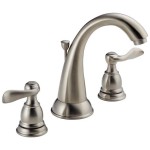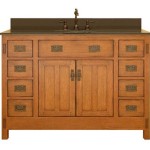Most Popular Bathroom Sinks: A Guide to Styles and Trends
The bathroom sink, more formally known as a washbasin, is a crucial fixture in any bathroom. Beyond its functional purpose of providing a place for handwashing and grooming, the sink also plays a significant role in the overall aesthetic of the space. The market offers a wide variety of bathroom sinks, each with its own unique design, material, and installation method. Understanding the different types of sinks and their associated benefits can aid in making an informed decision that complements both personal style and bathroom functionality.
This article explores some of the most popular bathroom sink styles, discussing their characteristics, advantages, and considerations for installation. The aim is to provide a comprehensive overview to assist in selecting the ideal sink for a new bathroom build or a bathroom renovation project.
Vessel Sinks: A Statement of Style
Vessel sinks, also referred to as above-counter sinks, are designed to sit directly on top of the bathroom countertop. This distinctive placement makes them a focal point, contributing to a modern and often artistic aesthetic. Vessel sinks are available in a variety of materials, including ceramic, glass, stone, and metal, offering diverse options to match different bathroom styles. Their exposed design allows for creative variations in shape and color, providing opportunities for personalization.
One of the primary advantages of vessel sinks is their ease of installation. Since they rest on top of the countertop, the installation process typically involves cutting a hole for the drain and securing the sink in place. This simplicity can result in lower installation costs compared to other sink types. Furthermore, vessel sinks often require less cabinet space underneath, potentially freeing up room for storage or other bathroom essentials.
Despite their aesthetic appeal and ease of installation, vessel sinks also have certain considerations. The height of the countertop and the sink itself must be carefully considered to ensure comfortable use. If the countertop is too high, the sink may be too elevated, making it awkward to wash hands or perform other grooming tasks. Additionally, the exposed nature of vessel sinks can make them more susceptible to splashing, potentially requiring adjustments to sink placement or the addition of a backsplash.
Maintaining a vessel sink typically involves regular cleaning to prevent water stains and buildup. Depending on the material, special cleaning agents might be necessary to preserve its finish and prevent damage. Despite these considerations, the visual impact and design flexibility of vessel sinks make them a popular choice for those seeking a statement piece in their bathroom.
Undermount Sinks: Seamless Integration
Undermount sinks are installed beneath the countertop, creating a seamless transition between the sink and the surrounding surface. This installation method offers a clean and minimalist look, allowing the countertop material to be prominently displayed. Undermount sinks are commonly used with solid surface countertops such as granite, quartz, or marble, where the edge of the material is exposed and polished.
A key advantage of undermount sinks is their ease of cleaning. The absence of a lip or rim around the sink eliminates areas where dirt and grime can accumulate. Water and debris can be easily wiped directly into the sink, simplifying the cleaning process. This feature is particularly beneficial in bathrooms with limited counter space, as it maximizes the usable surface area.
However, the installation of undermount sinks is generally more complex compared to vessel sinks. It requires precise cutting and sealing of the countertop, which is typically done by a professional fabricator. The sink is then attached to the underside of the countertop using clips and adhesives. This more involved installation can result in higher costs. Furthermore, undermount sinks are typically limited to heavier, non-porous countertop materials that can support their weight.
When selecting an undermount sink, it's essential to consider the shape and size of the basin. Options range from rectangular and oval to round and square, with varying depths and widths. The choice should be based on the intended use and the overall design of the bathroom. A larger undermount sink may be suitable for master bathrooms, while a smaller sink may be sufficient for powder rooms or guest bathrooms.
The aesthetic appeal and ease of cleaning associated with undermount sinks make them a popular choice for those seeking a clean, contemporary look. While the installation process may be more involved, the resulting seamless integration can greatly enhance the overall appearance of the bathroom.
Pedestal Sinks: Timeless Elegance
Pedestal sinks consist of a basin supported by a freestanding pedestal base. This classic design has been a staple in bathrooms for many years, known for its simplicity and elegance. Pedestal sinks are particularly well-suited for smaller bathrooms, as they occupy minimal floor space and create an open and airy feel.
One of the main advantages of pedestal sinks is their aesthetic appeal. The clean lines and simple form of a pedestal sink can complement a variety of bathroom styles, from traditional to contemporary. They are also relatively easy to install, requiring only the attachment of the basin to the pedestal and the connection of plumbing fixtures.
However, pedestal sinks offer limited storage space. Unlike vanity sinks, they do not have cabinets or drawers underneath the basin, which can be a drawback for those who require storage for toiletries and other bathroom essentials. This limitation can be addressed by incorporating alternative storage solutions, such as wall-mounted shelves or cabinets.
Another consideration with pedestal sinks is the stability of the base. It is essential to ensure that the pedestal is securely attached to the floor to prevent wobbling or tipping. This generally involves anchoring the pedestal to the subfloor using screws or bolts. The weight of the basin and the pedestal should also be taken into account to ensure that the floor can adequately support the fixture.
Pedestal sinks offer a timeless and elegant solution for bathrooms, particularly those with limited space. While they may not provide the same storage options as vanity sinks, their aesthetic appeal and ease of installation make them a popular choice for many homeowners.
Wall-Mounted Sinks: Space-Saving Solutions
Wall-mounted sinks, as the name suggests, are directly attached to the wall without the need for a pedestal or cabinet. This type of sink offers a space-saving solution, making it ideal for small bathrooms or powder rooms where floor space is at a premium. Wall-mounted sinks also create a clean and minimalist look, contributing to a modern and uncluttered aesthetic.
One of the key advantages of wall-mounted sinks is their flexibility in terms of height adjustment. The sink can be installed at any desired height, making it suitable for users of different heights and abilities. This feature is particularly beneficial for accessible bathrooms designed to accommodate individuals with mobility challenges.
However, the installation of wall-mounted sinks requires careful planning and execution. The wall must be structurally sound enough to support the weight of the sink and any associated plumbing fixtures. It is often necessary to reinforce the wall with additional framing or backing to ensure stability. Furthermore, the plumbing connections must be concealed within the wall, which may require professional installation.
Similar to pedestal sinks, wall-mounted sinks offer limited storage space. Without a cabinet or pedestal underneath, there is no built-in storage for toiletries or other bathroom essentials. This limitation can be addressed by incorporating alternative storage solutions, such as wall-mounted cabinets or shelves.
Wall-mounted sinks provide a space-saving and aesthetically pleasing solution for bathrooms. Their flexibility in terms of height adjustment and their minimalist design make them a popular choice for modern bathrooms and accessible spaces. While the installation process may be more involved, the resulting clean and uncluttered look can greatly enhance the overall appearance of the bathroom.
Console Sinks: Balancing Style and Function
Console sinks combine the design elements of pedestal and vanity sinks. These sinks typically feature a basin supported by legs or a frame, often made of metal. Console sinks offer a more substantial look than pedestal sinks while providing some storage space, albeit often limited, compared to full vanity cabinets.
The advantages of console sinks include their blend of style and functionality. The exposed legs or frame create a visually appealing design, while the small shelf or towel bar that is often included provides a convenient place to store towels or toiletries. Console sinks can complement a variety of bathroom styles, from traditional to modern.
One of the key considerations with console sinks is the material and finish of the legs or frame. Metal frames are commonly used, and they come in a variety of finishes, such as chrome, nickel, and brass. The finish should be chosen to complement the other fixtures in the bathroom, such as the faucets and lighting.
The installation of console sinks typically involves attaching the basin to the legs or frame and securing the entire assembly to the wall. This helps to provide additional stability. The plumbing connections must also be properly installed and concealed, which may require professional assistance.
Console sinks offer a compromise between the minimalist design of pedestal sinks and the storage capacity of vanity sinks. Their blend of style and functionality makes them a popular choice for those seeking a balance between aesthetics and practicality in their bathroom design.
The selection of the most popular bathroom sink ultimately depends on individual preferences, bathroom size, desired aesthetic, and budget. Each type of sink offers its own unique set of advantages and considerations. A careful evaluation of these factors can help to ensure that the chosen sink complements both the style and functionality of the bathroom.

9 Attractive Bathroom Sinks For 2024 Best

10 Best Bathroom Sinks Review The Jerum Post

Common Sink Sizes How To Choose The Right Bathroom 2024

The Best Bathroom Sinks In 2024 Domino

Bathroom Sinks The Home Depot

7 Most Popular Modern Bathroom Sinks For 2024 The Jerum Post

8 Trending Bathroom Sink Styles You Need To Know

Bathroom Vanity Styles To Fit Your Space Forbes Home

Complete Buyers Guide To Countertop Bathroom Basins

Luxury Natural Stone Basins
Related Posts







